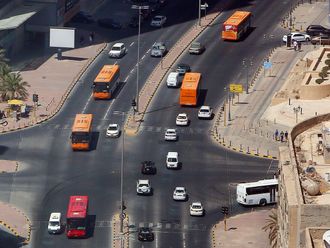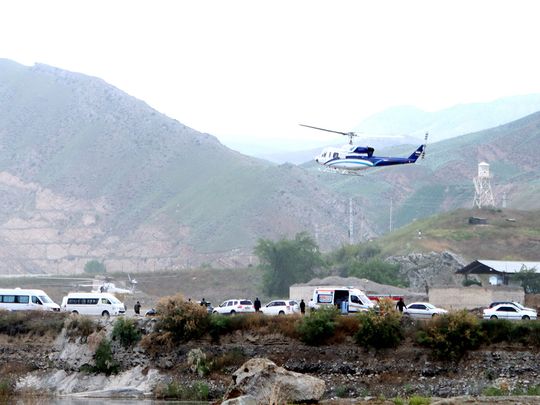
Dubai: Iranian President Ebrahim Raisi was killed in a helicopter crash in mountainous terrain near the Azerbaijan border, officials and state media said on Monday. Foreign Minister Hossein AmirAbdollahian was also among those killed, along with seven others.
The charred wreckage of the helicopter which crashed on Sunday carrying Raisi and Amirabdollahian was found early on Monday after an overnight search in blizzard conditions.
Raisi's death was later confirmed in a statement on social media by Vice President Mohsen Mansouri and on state television.
State TV reported that images from the site showed the aircraft slammed into a mountain peak, although there was no official word on the cause of the crash.
State news agency IRNA said Raisi was flying in a US-made Bell 212 helicopter.
Iran vice president to assume interim duties
Iran's supreme leader Ayatollah Ali Khamenei assigned vice president Mohammad Mokhber to assume interim duties after the death of Raisi.
"In accordance with Article 131 of the constitution, Mokhber is in charge of leading the executive branch," said Khamenei in a statement, adding that Mokhber will be required to work with the heads of legislative and judicial to prepare for presidential elections "within a maximum period of 50 days".
Ali Bagheri Kani appointed as acting FM
Iran's government cabinet appointed Deputy Foreign Minister Ali Bagheri Kani as acting foreign minister following the death of Hossein Amirabdollahian in a helicopter crash.
Will operate 'without disruption'
The Iranian government will continue to operate "without the slightest disruption" following the death of president Ebrahim Raisi, said a cabinet statement on Monday.
"We assure the loyal nation that the path of service will continue with the tireless spirit of Ayatollah Raisi," said the statement, stressing that government's work will continue "without the slightest disruption".
Ayatollah Ali Khamenei had earlier sought to reassure Iranians, saying there would be no disruption to state affairs.
Five-day mourning declared
Khamenei also announced five days of mourning for President Ebrahim Raisi who died in a helicopter crash.
"I announce five days of public mourning and offer my condolences to the dear people of Iran," said Khamenei in an official statement a day after the death of Raisi and other officials in the crash in East Azerbaijan province.
Bodies recovered from crash site
The Red Crescent said that the bodies of Raisi and others had been recovered, and search operations had ended.
"We are in the process of transferring the bodies of the martyrs to Tabriz" in Iran's northwest, Red Crescent chief Pirhossein Koolivand told state TV, adding that "the search operations have come to an end."
'Extremely difficult' search
Almost 10 hours into the search, it was "extremely difficult" because of darkness and heavy fog and rain, Pirhossein Koulivand, head of Iran's Emergency Medical Services, told state TV. Earlier, Iran's interior minister, Ahmad Vahidi, said finding the president's helicopter was likely to take time because of the adverse conditions.
The Turkish ministry of defense said it dispatched an Akinci drone in response to a request from Iran. It also said a Cougar helicopter remains on alert to be deployed depending on weather conditions.
The European Union activated its rapid response mapping service following a request for help from Iran, the bloc's Commissioner for Crisis Management, Janez Lenarčič, said in a post on X.
Iranian television aired live footage of scores of ambulances amid heavy rain and fog. A reporter, stationed near the rescue teams, mentioned the challenges in reaching the crash site, citing impassable roads due to mud and the remote nature of the area.
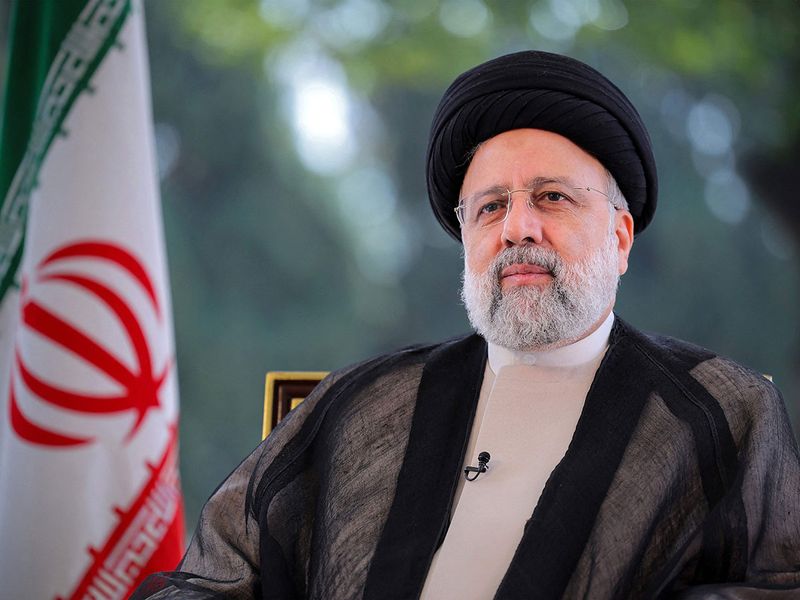
Prayers, searches
Iranian state media said bad weather caused the crash on Sunday and was complicating rescue efforts. State news agency IRNA said Raisi was flying in a US-made Bell 212 helicopter. The chief of staff of Iran's army ordered all resources of the army and the elite Revolutionary Guards to be put to use in search and rescue operations.
Iranian Supreme Leader Ayatollah Ali Khamenei, who holds ultimate power, saying there would be no disruption to state affairs.
In the early hours of Monday, it showed a rescue team, wearing bright jackets and head torches, huddled around a GPS device as they searched a pitch-black mountainside on foot in a blizzard.
We are thoroughly searching every inch of the general area of the crash," state media quoted a regional army commander as saying. "The area has very cold, rainy, and foggy weather conditions. The rain is gradually turning into snow."
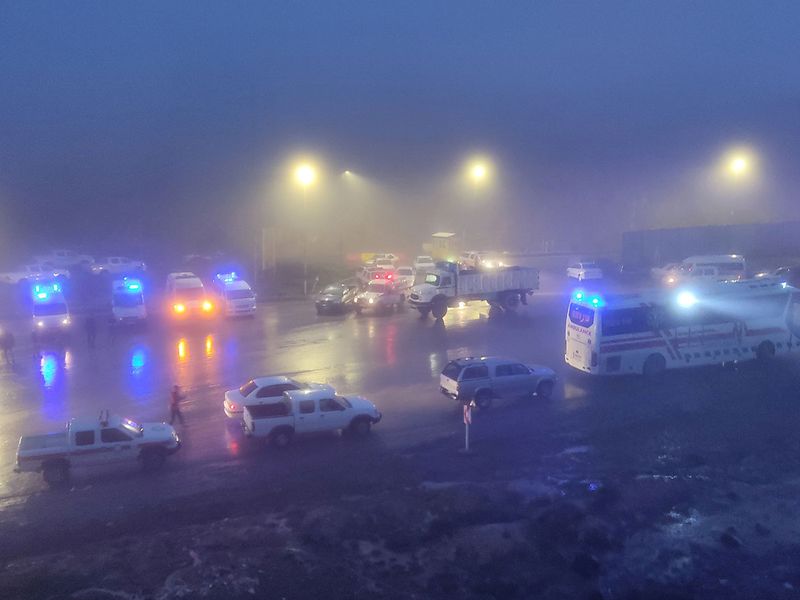
Expressions of concern and offers of help came from abroad, including Saudi Arabia, UAE, Qatar, Kuwait, Iraq, Syria, Russia, China and Turkey, as well as from the European Union which activated its rapid response mapping service to aid in the search effort.
As it happened: Here’s a look at the main developments overnight
UAE ready to support search and rescue operations
The UAE said it is following with concern the news reports about the incident involving a plane carrying Iranian President Ebrahim Raisi and his accompanying delegation.
The UAE affirmed its supporting stand by Iran and its willingness to support efforts in finding the President's helicopter, according to a statement by the Ministry of Foreign Affairs.
Saudi, Qatar offer help in helicopter search
Saudi Arabia on Sunday voiced "great concern" after Iranian state media reported that a helicopter carrying President Ebrahim Raisi had gone missing, and offered to help with the response.
"We affirm that the Kingdom stands by the sisterly Islamic Republic of Iran in these difficult circumstances and its readiness to provide any assistance that the Iranian agencies need," the foreign ministry of the Gulf kingdom, a longtime rival of Iran, said in a statement.
In a statement on X, formerly Twitter, Qatar expressed its "deep concern" over the helicopter carrying Iran's president and foreign minister and offered "to provide all forms of support in the search".
The Gulf state's foreign ministry spokesman Majed Al-Ansari gave "Qatar's wishes for the safety of the president, the foreign minister, and their companions", the statement added.
Erdogan offers Iran 'all necessary support'
Turkey's President Recep Tayyip Erdogan on Sunday said he was "profoundly saddened" at news of the helicopter accident involving Iran's President Ebrahim Raisi, and offered "all necessary support" to the search.
"We are following the incident closely, are in contact and in coordination with the Iranian authorities and we are ready to provide all necessary support," Erdogan posted on X, formerly Twitter.
A Turkish foreign ministry spokesman told AFP that Iran had requested technical support for its search.
"We are in the process of discussing the aid that could be sent over the fastest," he added.
EU activates mapping service
The European Union on Sunday said it had activated its "rapid response mapping service" to help Iran search for a helicopter carrying President Ebrahim Raisi that went missing on a fog-shrouded mountainside.
"Upon Iranian request for assistance we are activating the EU's CopernicusEMS rapid response mapping service in view of the helicopter accident reportedly carrying the President of Iran and its foreign minister" Hossein Amir-Abdollahian, EU Commissioner for Crisis Management Janez Lenarcic said on X.
Aliyev says his prayers are with Raisi
Azeri President Ilham Aliyev said he was profoundly troubled by the news.
"Today, after bidding a friendly farewell to the President of the Islamic Republic of Iran, Ebrahim Raisi, we were profoundly troubled by the news of a helicopter carrying the top delegation crash-landing in Iran," Aliyev said.
"Our prayers to Allah Almighty are with President Ebrahim Raisi and the accompanying delegation. As a neighbor, friend, and brotherly country, the Republic of Azerbaijan stands ready to offer any assistance needed."
Three rescue workers missing: Red Crescent
Meanwhile, a Red Crescent spokesperson said three rescue workers searching for the crashed helicopter have gone missing. The search teams are close to the where the helicopter may have crashed, the spokesperson added.
They said that the search operation will slow down as as the weather is expected to get "severely cold" soon, with more rain on the way.
A council consisting of the first vice president, the speaker of parliament and the head of the judiciary must arrange a election for a new president within a maximum period of 50 days. Raisi was elected president in 2021 and, under the current timetable, presidential elections are due to take place in 2025.
State TV stopped all its regular programming to show prayers being held for Raisi across the country and, in a corner of the screen, live coverage of rescue teams searching the mountainous area on foot in heavy fog.
The accident happened in the mountainous forest area of Dizmar near the town of Varzaghan, according to the official IRNA news agency.
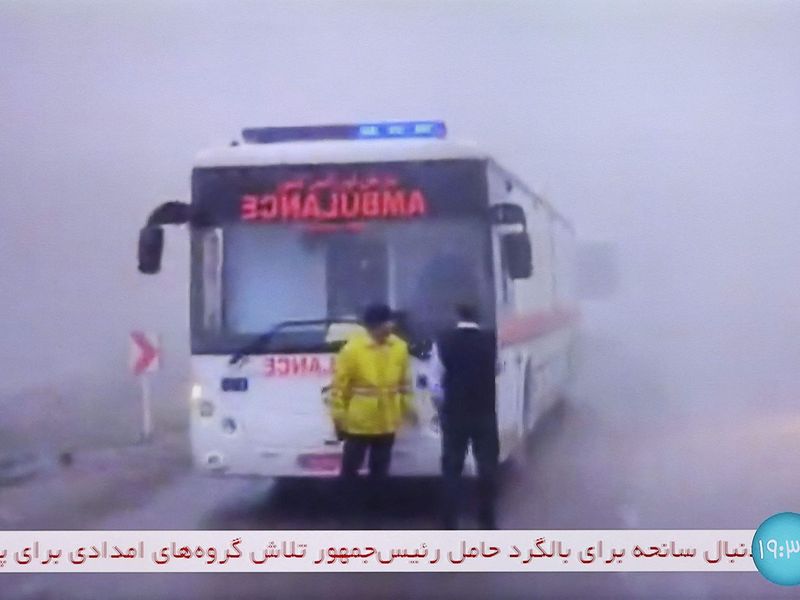
Raisi, 63, was visiting the province Sunday where he inaugurated a dam project together with his Azeri counterpart, Ilham Aliev, on the border between the two countries.
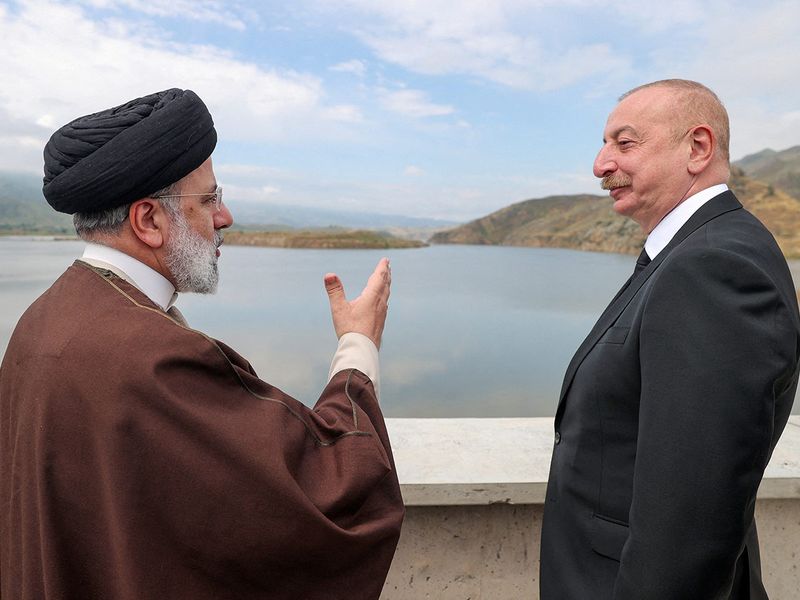
His convoy included three helicopters, and the other two had "reached their destination safely," according to Tasnim news agency.
The reformist Shargh daily reported that “the helicopter carrying the president crashed” while two other helicopters landed safely.
Iraq offers help
Iraq on Sunday offered neighbouring Iran help in search and rescue efforts.
Iraqi Prime Minister Mohamed Shia Al Sudani “instructed the interior ministry, the Iraqi Red Crescent and other relevant authorities to offer the Islamic Republic of Iran the available resources to aid in the search for the Iranian president’s aircraft,” government spokesman Bassem Al Awadi said in a statement.
Difficult weather conditions
Finding the president's helicopter "could take time" due to difficult weather conditions, Interior Minister Ahmad Vahidi said on TV, adding several rescue teams were trying to locate the site of the incident.
There was no immediate elaboration on what happened to the helicopter. Semiofficial news agencies offered varying explanations for what was happening.
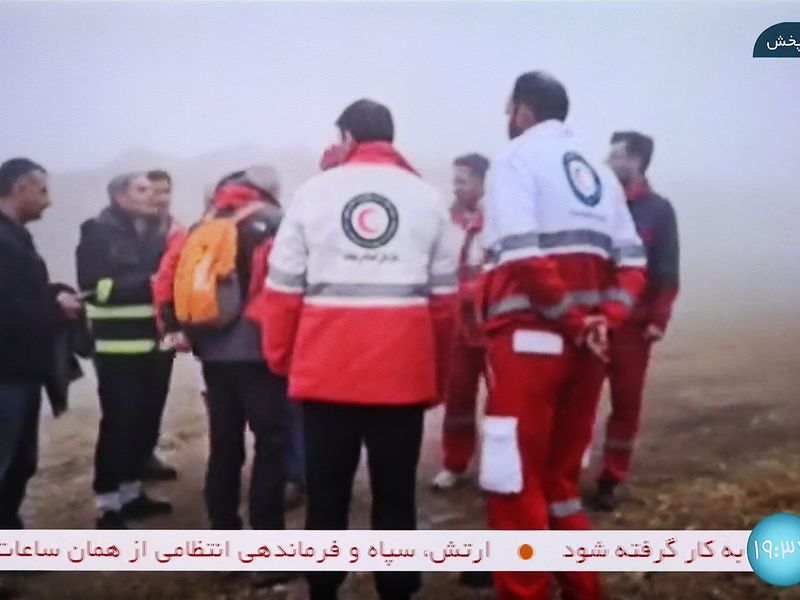
Raisi was travelling in Iran’s East Azerbaijan province. State TV described the area of the incident happening as being near Jolfa, a city on the border with with the nation of Azerbaijan, some 600km northwest of the Iranian capital, Tehran.
Raisi had been in Azerbaijan early Sunday to inaugurate a dam with Azerbaijan’s President Ilham Aliyev. The dam is the third one that the two nations built on the Aras River.
Iran flies a variety of helicopters in the country, but international sanctions make it difficult to obtain parts for them. Its military air fleet also largely dates back to before the 1979 Islamic Revolution.
Raisi is a hardliner who formerly led the country’s judiciary.
In Iran’s dual political system, split between the clerical establishment and the government, it is the supreme leader rather than the president who has the final say on all major policies.
But many have seen Raisi as a strong contender to succeed his 85-year-old mentor, Supreme Leader Ayatollah Ali Khamenei, who has strongly endorsed Raisi’s main policies.
Raisi’s victory in a closely managed election in 2021 brought all branches of power under the control of hardliners, after eight years when the presidency had been held by pragmatist Hassan Rouhani, who negotiated a nuclear deal with Washington.
However, Raisi’s standing may have been dented by widespread protests against clerical rule and a failure to turn around Iran’s economy, hamstrung by Western sanctions.
Raisi had been at the Azerbaijani border to inaugurate the Qiz-Qalaisi Dam, a joint project.
What are the helicopter's origins?
Bell Helicopter (now Bell Textron, a division of Textron Inc ) developed the aircraft for the Canadian military in the late 1960s as an upgrade of the original UH-1 Iroquois. The new design used two turboshaft engines instead of one, giving it greater carrying capacity. The helicopter was introduced in 1971 and quickly adopted by both the United States and Canada, according to US military training documents.
What are its uses?
As a utility helicopter - the UH in its military designation represents those words - the Bell 212 is meant to be adaptable to all sorts of situations, including carrying people, deploying aerial firefighting gear, ferrying cargo and mounting weapons.
The Iranian model that crashed on Sunday was configured to carry government passengers. Bell Helicopter advertises the latest version, the Subaru Bell 412, for police use, medical transport, troop transport, the energy industry and firefighting. According to its type certification documents with the European Union Aviation Safety Agency, it can carry 15 people, including the crew.
Which organisations operate the helicopter?
Non-military organisations that fly the Bell 212 include Japan's Coast Guard; law enforcement agencies and fire departments in the United States and many others. It is not clear how many Iran's government operates, but its air force and navy have a total of 10, according to FlightGlobal's 2024 World Air Forces directory.
Have there been other incidents involving the bell 212?
The most recent fatal crash of a Bell 212 was in September 2023, according to the Flight Safety Foundation, a non-profit focusing on aviation safety. The most recent Iranian crash of the type was in 2018, killing four people, according to the organisation's database.
Years of crisis and conflict
Raisi took the reins of a country in the grip of a deep social crisis and an economy strained by US sanctions against Tehran over its contested nuclear programme.
Iran saw a wave of mass protests triggered by the death in custody of Iranian-Kurd Mahsa Amini in September 2022.
In March 2023, regional rivals Iran and Saudi Arabia signed a surprise deal that restored diplomatic relations.
The war in Gaza that began on October 7 sent regional tensions soaring again and a series of tit-for-tat escalations led to Tehran launching hundreds of missiles and rockets directly at Israel from Iran in April 2024.
Raisi, born in 1960 in northeast Iran’s holy city of Mashhad, rose early to high office. Aged just 20, in the wake of the 1979 Islamic revolution that toppled the US-backed monarchy, he was named prosecutor-general of Karaj next to Tehran.
He served as Tehran’s prosecutor-general from 1989 to 1994, deputy chief of the Judicial Authority for a decade from 2004, and then national prosecutor-general in 2014.











